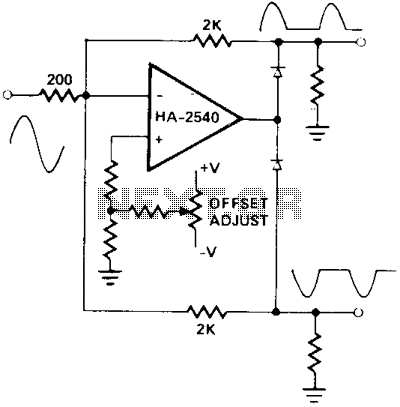
Wideband-signal-splitter

A circuit utilizing either the HA-2539 or HA-2540 in conjunction with two low-capacitance switching diodes can effectively separate signals exceeding 10 MHz. This configuration is particularly beneficial for applications such as full-wave rectification, AM detection, or synchronization generation.
The described circuit employs the HA-2539 or HA-2540, which are high-speed operational amplifiers, known for their ability to handle high-frequency signals. The low-capacitance switching diodes are critical components that facilitate rapid signal switching, thereby ensuring minimal signal distortion and loss during the separation process.
In practical applications, this circuit can be implemented in various electronic systems where high-frequency signal processing is required. For full-wave rectification, the circuit efficiently converts alternating current (AC) signals into direct current (DC), allowing for the extraction of power from high-frequency sources. In AM detection, the circuit demodulates amplitude-modulated signals, enabling the recovery of audio or data information transmitted over radio frequencies. Additionally, for synchronization generation, the circuit can produce a stable reference signal that can be used to synchronize other components in a system, enhancing overall performance and reliability.
When designing this circuit, careful consideration must be given to the selection of components to ensure compatibility with the desired frequency range and application requirements. Proper layout techniques should be employed to minimize parasitic capacitance and inductance, which can adversely affect high-frequency performance. Overall, the combination of the HA-2539 or HA-2540 with low-capacitance switching diodes presents a robust solution for high-frequency signal processing in various electronic applications.With one HA-2539 or HA-2540 and two low-capacitance switching diodes, signals exceeding 10 MHz can be separated. This circuit is most useful for full-wave rectification, AM detection, or sync generation. 🔗 External reference
The described circuit employs the HA-2539 or HA-2540, which are high-speed operational amplifiers, known for their ability to handle high-frequency signals. The low-capacitance switching diodes are critical components that facilitate rapid signal switching, thereby ensuring minimal signal distortion and loss during the separation process.
In practical applications, this circuit can be implemented in various electronic systems where high-frequency signal processing is required. For full-wave rectification, the circuit efficiently converts alternating current (AC) signals into direct current (DC), allowing for the extraction of power from high-frequency sources. In AM detection, the circuit demodulates amplitude-modulated signals, enabling the recovery of audio or data information transmitted over radio frequencies. Additionally, for synchronization generation, the circuit can produce a stable reference signal that can be used to synchronize other components in a system, enhancing overall performance and reliability.
When designing this circuit, careful consideration must be given to the selection of components to ensure compatibility with the desired frequency range and application requirements. Proper layout techniques should be employed to minimize parasitic capacitance and inductance, which can adversely affect high-frequency performance. Overall, the combination of the HA-2539 or HA-2540 with low-capacitance switching diodes presents a robust solution for high-frequency signal processing in various electronic applications.With one HA-2539 or HA-2540 and two low-capacitance switching diodes, signals exceeding 10 MHz can be separated. This circuit is most useful for full-wave rectification, AM detection, or sync generation. 🔗 External reference